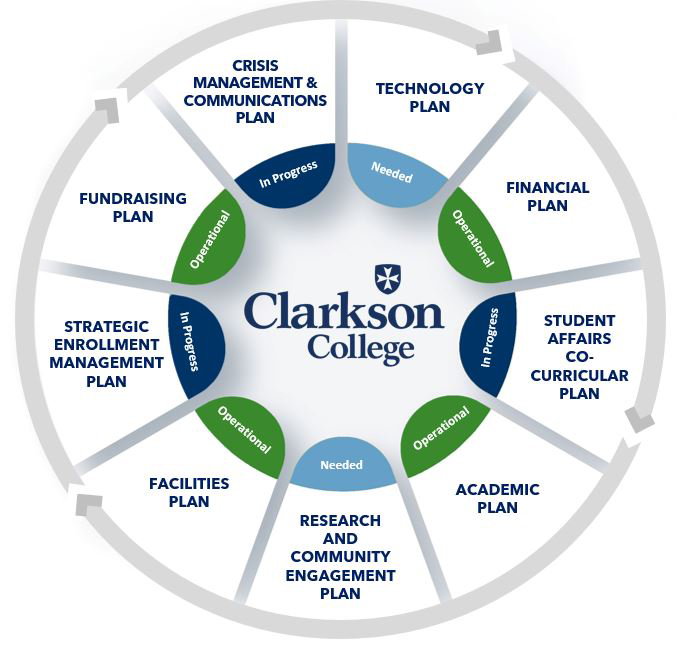Strategic Roadmap
Strategic Intent
Clarkson College has a financially stable model supported by mission-consistent, demand-driven programs, expanded student scholarship and training partners, and a strong brand supported by alumni.
Critical Success Factors
Overarching College Strategic Goals
- We will evaluate and improve academic services.
- We will improve services to our students.
- We will assess and improve the quality of the College.
- We will implement annual goals to meet immediate needs.

College Priorities
- Serve our students and community well
- Increase customer services
- Achieve financial sustainability through visibility
Strategic Driver One
Expand student scholarship and educational partnership programs.
- Enhance and grow Nebraska Medicine relationship
- Develop rural health care hospital network training partnerships
- Expand preceptor sites with a focus on potential scholarship/work commitment programs
Critical Success Factors
Implement a partnership and rural engagement structure to better serve the community, increase awareness of Clarkson College, and increase enrollment into academic programs and community advancement opportunities. The long-term outcomes of this strategy are to support urban and rural health care needs in NE and across College enrollment demographics to sustain and grow enrollment and brand awareness beginning in 2023 and further developed through 2028.
Strategic Driver Two
Develop a financially sustainable model.
- Ongoing system of analysis/review/adjustment of tuition and program costs/break-even points
- Develop processes to increase enrollment to 1,500 in three years
- Explore and launch potential non-tuition revenue sources
Critical Success Factors
Student Services CSF Goal B.1:
Clarkson College will be a student-ready institution through the development, implementation, and review of focused plans common in best practices for higher education to support the college community. This will be completed beginning in 2024 and fully operational by the fall of 2026. The long-term outcomes of this strategy are to improve overall communication, establish clear practices, and improve the overall college experience.
Strategic Driver Three
Grow mission-consistent demand-driven quality programs.
- Expand Graduate and UG Nursing Programs
- Expand Community Health Programs, including Pre-Health Professional
- Expand new Undergraduate Psychology Program
Critical Success Factors
Explore new academic programming or tracks to meet the mission of Clarkson College. Explore, develop, and implement new and current programming (academic and/or community programming). The long-term outcomes of this strategy are to be leading and forward-thinking educators.
Quality Improvement CSF Goal C.1:
Implementation of a long-term plan: The Path to 150 Years was built on the premises academic growth, facilities development, and financial forecasting that will promote the overarching College Foundational Values of Learning (CTE), Caring (Service), Commitment (IPE), Excellence (Wellness), and Integrity (All Operations).
Strategic Driver Four
Develop a strong brand enabling support from alumni and others.
- Increase alumni engagement
- Expand and ensure brand consistency
- Increase grant and foundation funding
- Create a plan for large donor development
Critical Success Factors
Quality Improvement CSF Goal C.2:
Develop opportunities for the College traditional and non-traditional, online, and on-campus students to be engaged with Clarkson College extended from AY 2024-2025 through 2027.
